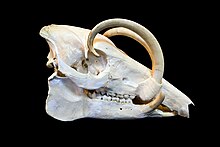North Sulawesi babirusa
| North Sulawesi babirusa | |
|---|---|

| |
| Adult male | |

| |
| Scientific classification | |
| Domain: | Eukaryota |
| Kingdom: | Animalia |
| Phylum: | Chordata |
| Class: | Mammalia |
| Order: | Artiodactyla |
| Family: | Suidae |
| Genus: | Babyrousa |
| Species: | B. celebensis
|
| Binomial name | |
| Babyrousa celebensis Deninger, 1909
| |

| |
The North Sulawesi babirusa (Babyrousa celebensis) is a pig-like animal native to
The common and scientific names are various transcriptions of its local name, which literally translated means "pig-deer" (from
Classification
Together with the other members of the
Most experts agree that babirusas are part of the pig family, and are one of the oldest living members of the family, representing a subfamily, Babyrousinae, that branched off from the warthog branch of the pig family (Subfamily Phacochoerini) during the Oligocene or early Miocene.
Appearance
The North Sulawesi babirusa has a head-and-body length of 85–110 cm (33–43 in) and weighs up to 100 kg (220 lb).[6] It is virtually hairless (easily revealing its greyish skin), and the tail-tuft is also nearly hairless. In males, the relatively long and thick upper canines are strongly curved.[5][6] They emerge through the roof of the snout, while the long lower canines emerge through the side of the mouth. The upper canines can grow backwards in a curve until they penetrate the skull of the male babirusa.[7]
In females, the canines are far shorter and typically do not protrude. In comparison, the Buru babirusa has relatively long, thick body hair, a well-developed tail-tuft, and relatively short and slender upper canines in males, while the Togian babirusa is larger, has a relatively well-developed tail-tuft, and the upper canines of the male are "short, slender, rotated forwards, and always converge".[5][6][8]
Habitat
Its habitat is the underbrush of tropical forests and canebrakes, and the shores of rivers and lakes. Its mostly-hairless, mottled-grey-and-brown hide provide it with a degree of camouflage. The North Sulawesi Babirusa is known for its two pairs of tusks; both its upper and its lower pairs of canine teeth are greatly enlarged, and curve up and back towards the head. The upper canines of the male are so curved and enlarged that they emerge through the flesh, by way of holes, to pass through the top of the snout.


This species is protected by Indonesian law but is threatened by illegal hunting.[9]
Captivity
In captivity, the species is very
In 2006, a male North Sulawesi Babirusa and a female domestic pig were accidentally allowed to
References
- ^ . Retrieved 19 November 2021.
- ^ "Appendices | CITES". cites.org. Retrieved 2022-01-14.
- OCLC 62265494.
- ^ "Babirusa | Definition of Babirusa by Merriam-Webster". Merriam-webster.com. Retrieved 2017-05-13.
- ^ a b c Meijaard, E. and Groves, C. P. (2002). Upgrading three subspecies of Babirusa (Babyrousa sp.) to full species level. IUCN/SSC Pigs, Peccaries, and Hippos Specialist Group (PPHSG) Newsletter 2(2): 33-39.
- ^ ISBN 978-84-96553-77-4
- ^ Naish, Darren (2010-03-08). "Babirusas can get impaled by their own teeth: that most sought-after of objects does exist! (babirusas, part VIII) – Tetrapod Zoology". Scienceblogs.com. Retrieved 2017-05-13.
- ^ Nash, D. (February 23, 2010). The many babirusa species (babirusas, part VI). Archived 2012-05-06 at the Wayback Machine Scienceblogs. Accessed May 1, 2012
- S2CID 84039892.
- S2CID 19659979.
- bioRxiv 10.1101/289892.

